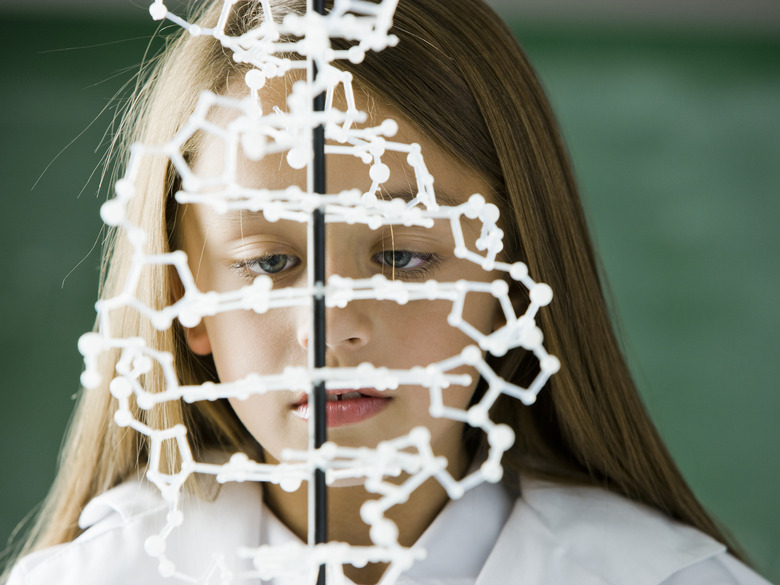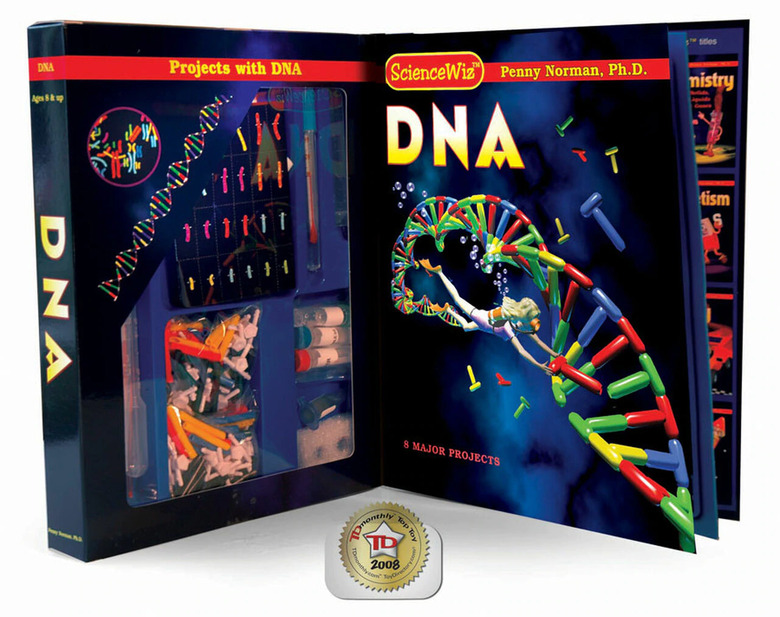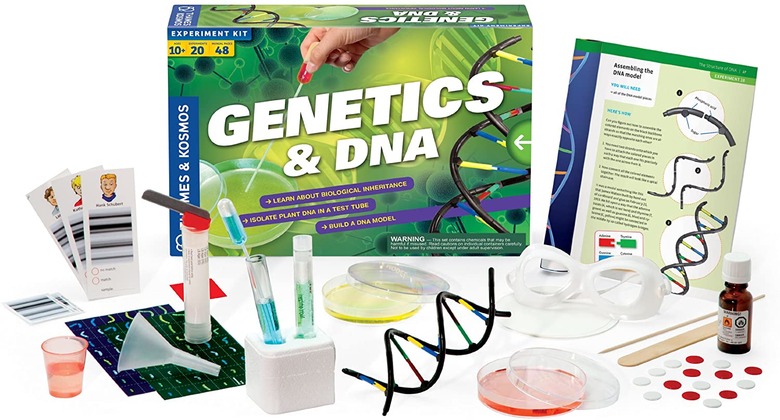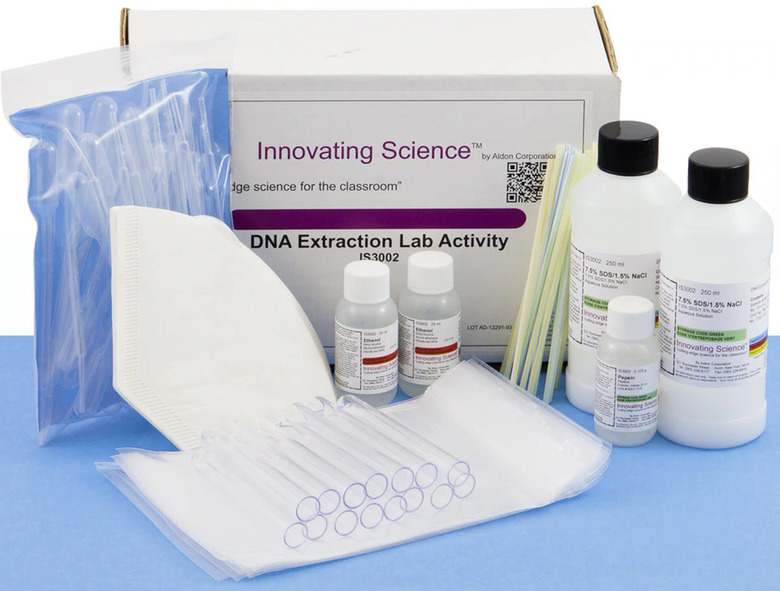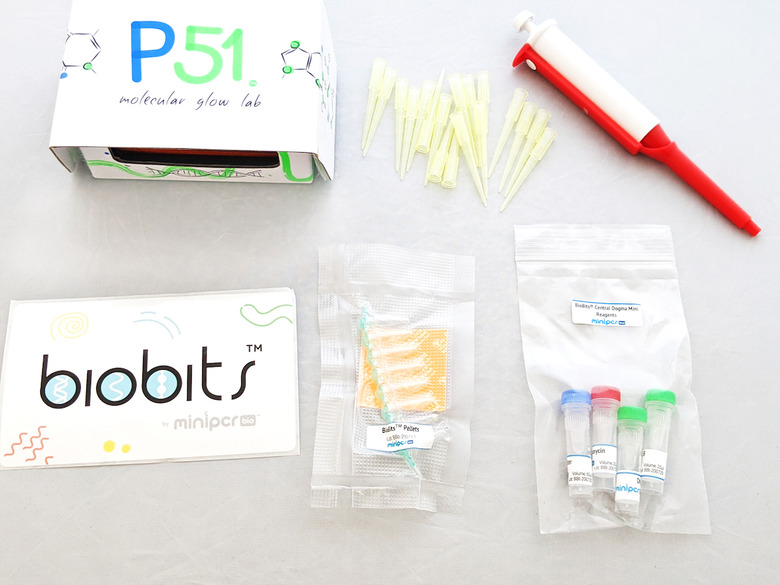Extract Your Own DNA And More With These Awesome Science Kits
We may receive a commission on purchases made from links.
Sciencing may earn compensation through affiliate links in this article.
There are tons of home science kit options out there, but most of them keep the focus on more "home-friendly" activities relating to things like physics and coding. If you're looking for something to teach important lessons about biology and DNA in particular, while your options are definitely more limited, you can still find some great kits out there. So if you want a DNA kit, there are enough options to get the most out of home-based biology lessons, including more basic options focused around a DNA model and more hands-on, high-level experiments.
K’Nex Education DNA Replication and Transcription Set
K'Nex Education DNA Replication and Transcription Set
This US&ref=as_li_ss_tl'>kit from K'Nex Education is primarily a DNA model, introducing kids to the double helix structure and the basics of both DNA and RNA. The kit contains over 500 pieces, which can be used to make 19 different DNA and RNA models, with the kit recommended for kids aged 10 and over working in pairs or groups of three. The color-coding of the model is also done intelligently: For instance, when modeling DNA replication, the old sugars and new sugars use different block colors, showing how the replication process works in an intuitive way.
Of course, building the models themselves won't necessarily teach your kids too much about the actual science of DNA or RNA, but the kit includes a Teacher's Guide which supplements the building with lessons on the biochemistry of DNA. These lessons cover the structure of DNA and RNA (deoxyribonucleic acid and ribonucleic acid, respectively), replication, the process of transcription, how the coding works, translation and the process of mutation. Overall, especially with a teacher to guide students, the kit introduces a lot of crucial concepts in a fun and natural way.
Science Wiz DNA Kit
Science Wiz DNA Kit
The Science Wiz DNA Kit is a great option if you're looking for something more substantial in terms of scientific content but still want something affordable. The kit includes multiple activities, including extracting DNA from fruit and your cheek cells, building a "ladder" model of DNA and solving a chromosome puzzle. The kit contains some good equipment too, including a lysis buffer, cytology brushes, a measuring tube, a thermometer, a base for making your own DNA ink, filter paper and the parts for both the DNA model and the chromosome puzzle.
The kit also comes with a 40-page manual that leads you through the 8 major activities in the kit, as well as teaching your child the basics of DNA (including introducing the four bases), how DNA duplicates, how the coding of DNA works and what chromosomes are. The manual is illustrated and aims to incorporate the "whys" of what your kid is doing alongside the "how." It's intended for ages 9 and up.
Thames & Kosmos Genetics & DNA Kit
Thames & Kosmos Genetics & DNA Kit
The US&ref=as_li_ss_tl'>Genetics & DNA kit from Thames & Kosmos aims to teach kids aged 10 and above about the basics of genetics and DNA, through a total of 20 small experiments and activities. The kit contains most of the equipment you need to complete the activities (aside from things you'll have in your home anyway, you'll need to get some denatured alcohol), including a test tube with a stopper, a petri dish and agar, a pipette, filter paper, a measuring cup, a chromosome puzzle with genetic fingerprinting cards, a DNA model and more. You'll need to supervise the activities, but generally speaking they're explained clearly enough for your kid to work through with minimal help.
The activities are split into six groups, isolating the DNA from a tomato, decoding the structure of DNA, how forensic scientists use DNA to solve crimes, the basics of heredity, an introduction to genetic engineering and activities on cells and chromosomes. It comes with a 48-page manual that guides you through the activities and experiments while giving kids an introduction to the concepts (for example, the DNA model building blocks are color-coded and the manual makes it clear that adenine links with thymine and guanine links with cytosine) and even the history of the science.
Innovating Science DNA Extraction Kit
Innovating Science DNA Extraction Kit
The DNA Extraction Kit from Innovating Science is a pretty advanced kit, intended for kids aged 12 and over who really want to get to grips with DNA science. The kit is intended for a classroom, so you get tons of the equipment and can repeat the experiment multiple times or with several kids. The kit contains pepsin (to break down proteins), two 25 ml bottles of ethanol, zipper bags, filters, plastic tubes, graduated pipettes and two 250 ml bottles of a biological detergent. You do need to provide safety gear, though, with the company recommending gloves, goggles and an apron.
The kit comes with both a teacher's manual and a student study guide to guide you through the activity. The material introduces students to the history of the discovery of DNA, the double helix structure of DNA, how DNA and proteins influence genetic expression and the basics of genetic inheritance. The real value of this kit, though, is in the ability to extract real DNA from plants and the ability to learn how to perform experiments to a more professional standard than many science kits.
BioBits @home: Central Dogma
BioBits @home: Central Dogma
The BioBits Central Dogma home kit is a fantastic option if you want something both hands-on and informative, focused on the "central dogma" of molecular biology, i.e. that information from DNA is passed to RNA in order to make proteins. The kit comes with a mini lab (with the reagents and pellets containing RNA, ribosomes, ribonucleotides, amino acids and ATP), P51 molecular fluorescence viewer, a 9V battery, a 4 μl (micro-liter) mini pipette, 20 disposable tips for the pipette and a 20 page activity guide.
The guide is detailed and clear, going through the science behind the experiment clearly, split into sections on transcription (the process of moving the information from DNA to mRNA) and translation (using the information to create protein), aided by diagrams along the way. The lab setup and experimental section is also clear and encourages scientific thinking throughout. It comes with enough material to go through two runs of the experiment in case there are problems with the first attempt. The kit doesn't have a recommended age, but it's best suited to high school students.
Cite This Article
MLA
Johnson, Lee. "Extract Your Own DNA And More With These Awesome Science Kits" sciencing.com, https://www.sciencing.com/best-dna-science-kits-13763824/. 31 March 2021.
APA
Johnson, Lee. (2021, March 31). Extract Your Own DNA And More With These Awesome Science Kits. sciencing.com. Retrieved from https://www.sciencing.com/best-dna-science-kits-13763824/
Chicago
Johnson, Lee. Extract Your Own DNA And More With These Awesome Science Kits last modified August 30, 2022. https://www.sciencing.com/best-dna-science-kits-13763824/
